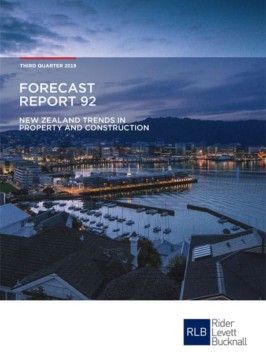The Rider Levett Bucknall (RLB) Forecast 92 report – New Zealand Trends in Property and Construction – confirms that construction activity has picked up across key construction markets.
Prepared by the New Zealand Institute of Economic Research (Inc.) (NZIER) exclusively for RLB, Forecast 92 noted that while Auckland continues to dominate construction demand, reflecting the effects of strong population growth in the region over the past few years, construction demand is broadening to other regions.
According to RLB Director, Grant Watkins, ‘Residential consent issuance in Canterbury is starting to recover after easing since 2015. Demand is also picking up in Waikato and Wellington, as higher house prices encourage new housing supply to come on board.’
Non-residential consent issuance in these regions has also increased over the past year, reflecting stronger demand for social buildings. Earthquake strengthening also continues to underpin office construction demand in Wellington.
Although the absolute level of construction in the Canterbury region is picking up, as a proportion of total construction nationwide, it continues to ease.
Cost inflation eases in Auckland but picks up in smaller regions
The increase in construction activity outside the main centres has seen construction cost inflation pick up in the smaller regions. In contrast, construction cost inflation in Auckland is moderating, with annual growth in costs easing from over 8 percent in late 2016 to just under 3 percent in the first quarter of 2019. Construction cost inflation in Canterbury and Wellington have also edged below 3 percent, indicating some easing in capacity pressures in the main centres.
Grant continued, ‘Despite this recent easing, we expect construction cost inflation in Auckland will be relatively high given the substantial amount of construction activity in the pipeline.’
‘We continue to expect high construction costs, along with a tightening by banks in accessing credit, will mean a protracted construction cycle in Auckland,’ he added.
The growth in construction costs is expected to moderate over the coming years, as rising prices attract more resources, such as workers, into the construction sector.
Growth in non-residential driven by social, storage, retail and hotels
According to RLB, non-residential construction consent issuance shows demand picking up, similar to the highs seen in the previous building boom of 2008. In contrast, there has been some easing in construction cost pressures.
Strong demand for social and storage buildings, retail outlets and hotels have driven the growth in non-residential consent issuance over the past year. In contrast, there has been a fall in demand for new office space and farm and industrial buildings. The recent easing in global commodity prices is likely to make farmers more cautious about on-farm investment.
Strong population growth and tourist activity underpins demand
Grant added that, although demand for storage buildings is currently strong, continued uncertainty over the effects of a potential deterioration in the global growth outlook is likely to curtail demand for this and other types of industrial buildings over the coming year.
‘Over the longer term, robust migration-led population growth and tourist inflows should continue to underpin demand,’ he said.
‘In particular, we expect further growth in demand for new accommodation buildings in response to the high numbers of international visitors, as well as strong domestic tourism activity,’ he concluded.
Auckland, Waikato and Wellington leading non-residential construction demand
Growth in Auckland nonresidential construction issuance reflected stronger demand for retail outlets, storage buildings and hotels over the past year.
Increased demand for storage buildings was also a key driver of growth in non-residential construction consent issuance in Waikato over the past year. In Wellington, demand was more mixed. While there was increased demand for social buildings and office space, this was partly offset by reduced demand for hotels.
FURTHER INFORMATION:



